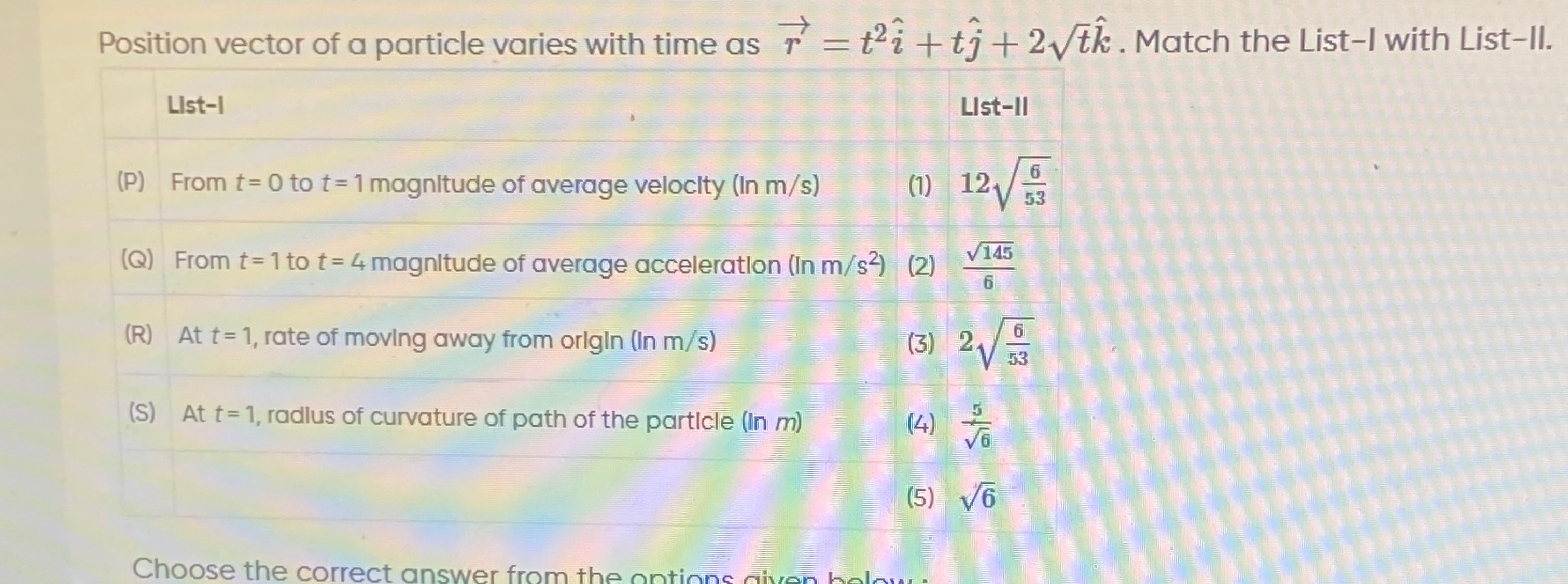Question
Question: Position vector of a particle varies with time as $\overrightarrow{r} = t^2\hat{i} + t\hat{j} + 2\sq...
Position vector of a particle varies with time as r=t2i^+tj^+2tk^. Match the List-I with List-II.
| List-I | List-II |
|---|---|
| (P) From t= 0 to t = 1 magnitude of average velocity (In m/s) | (1) 12536 |
| (Q) From t = 1 to t = 4 magnitude of average acceleration (In m/s²) | (2) 6145 |
| (R) At t = 1, rate of moving away from origin (In m/s) | (3) 2536 |
| (S) At t = 1, radius of curvature of path of the particle (In m) | (4) 65 |
| (5) 6 |
Choose the correct answer from the options given below.

P: (5), Q: (2), R: (4), S: (1)
Solution
Given:
r(t)=t2i^+tj^+2tk^- (P) Average velocity from t=0 to t=1:
r(1)=(1,1,2) and r(0)=(0,0,0).
Displacement =(1,1,2) with magnitude
$$ \sqrt{1^2+1^2+2^2}=\sqrt{6}.
Time interval $=1$ s so average velocity magnitude $=\sqrt{6}$ which matches option **(5)**. 2. **(Q) Average acceleration from $ t=1 $ to $ t=4 $:** First, find velocity: $$ \vec{v}(t)=\frac{d\vec{r}}{dt}=\left(2t,\,1,\,\frac{1}{\sqrt{t}}\right).At t=1: v(1)=(2,1,1).
At t=4: v(4)=(8,1,1/2).
Difference: Δv=(6,0,−21).
Magnitude of Δv:
$$ \sqrt{6^2+0^2+\left(\frac{1}{2}\right)^2}=\sqrt{36+\frac{1}{4}}=\sqrt{\frac{145}{4}}=\frac{\sqrt{145}}{2}.
Time interval is $3$ s, so average acceleration magnitude: $$ \frac{\sqrt{145}}{2\cdot 3}=\frac{\sqrt{145}}{6},which matches option (2).
- (R) Rate of moving away from the origin at t=1:
This rate is given by ∣r∣r⋅v.
At t=1: r=(1,1,2) and ∣r∣=6; v=(2,1,1).
Dot product: 1⋅2+1⋅1+2⋅1=5.
Thus the rate =65 which equals option (4).
- (S) Radius of curvature at t=1:
Curvature κ=∣v∣3∣v×a∣, and radius of curvature ρ=κ1.
Acceleration: $$ \vec{a}(t)=\frac{d\vec{v}}{dt}=\left(2,,0,,-\frac{1}{2t^{3/2}}\right).
At $ t=1 $: $\vec{a}(1)=(2,0,-\frac{1}{2})$ and $\vec{v}(1)=(2,1,1)$. Compute $\vec{v}\times\vec{a}$: $$ \begin{vmatrix} \hat{i} & \hat{j} & \hat{k} \\ 2 & 1 & 1 \\ 2 & 0 & -\frac{1}{2} \end{vmatrix} = -\frac{1}{2}\,\hat{i} + 3\,\hat{j} -2\,\hat{k}.Magnitude:
$$ \sqrt{\left(-\frac{1}{2}\right)^2+3^2+(-2)^2}=\sqrt{\frac{1}{4}+9+4}=\frac{\sqrt{53}}{2}.
Also, $ |\vec{v}(1)|=\sqrt{2^2+1^2+1^2}=\sqrt{6} $ so $ |\vec{v}(1)|^3=6\sqrt{6} $. Thus, $\kappa=\frac{\sqrt{53}/2}{6\sqrt{6}}=\frac{\sqrt{53}}{12\sqrt{6}}$ and $$ \rho=\frac{1}{\kappa}=\frac{12\sqrt{6}}{\sqrt{53}}=12\sqrt{\frac{6}{53}},which matches option (1).
Mapping:
- P → (5)
- Q → (2)
- R → (4)
- S → (1)
